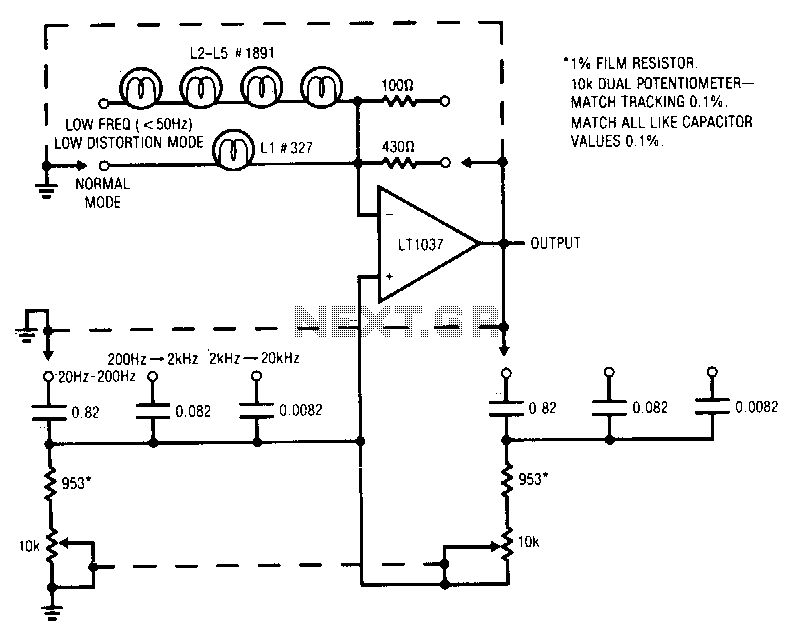
Stabilized-wien-bridge-oscillator

A variable Wien bridge provides frequency tuning from 20 Hz to 20 kHz. Gain control comes from the positive temperature coefficient of the lamp. When power is applied, the lamp has a low resistance value, resulting in high gain and an increase in oscillation amplitude. The lamp's gain-regulating behavior remains flat within 0.25 dB over the 20 Hz to 20 kHz range of the circuit. Distortion levels are below 0.003%. At lower frequencies, the thermal time constant of the small normal-mode lamp introduces distortion levels of about 0.01%. This occurs due to hunting when the oscillator's frequency approaches the lamp's thermal time constant. This effect can be mitigated, although it results in reduced output amplitude and a longer settling time, by switching to a low-frequency, low-distortion mode. The use of four large lamps provides a longer thermal time constant, thereby reducing distortion.
The described variable Wien bridge oscillator is a sophisticated circuit designed for precise frequency tuning across a wide range from 20 Hz to 20 kHz. The circuit employs a lamp whose resistance varies with temperature, providing a unique gain control mechanism. Initially, when the circuit is powered, the lamp's low resistance allows for a high gain, facilitating rapid oscillation amplitude buildup. The stability of gain across the specified frequency range is impressive, with variations kept within 0.25 dB, ensuring reliable performance for audio applications.
The distortion levels are exceptionally low, measured at below 0.003%, which is critical for maintaining signal integrity in high-fidelity audio systems. However, at lower frequencies, the thermal time constant associated with the small normal-mode lamp does lead to an increase in distortion, reaching approximately 0.01%. This phenomenon, referred to as hunting, occurs when the oscillator's frequency approaches the thermal time constant of the lamp, resulting in instability.
To counteract this distortion, the circuit can be switched to a low-frequency, low-distortion mode. This mode, while effective in reducing distortion, does result in a trade-off with output amplitude and an extended settling time. The implementation of four larger lamps in the circuit configuration enhances the overall thermal time constant, significantly mitigating distortion effects and ensuring a more stable output. This design choice is particularly advantageous in applications where signal fidelity is paramount, as it allows for sustained performance without the adverse effects of thermal lag.
Overall, this variable Wien bridge oscillator exemplifies a well-engineered solution for achieving accurate frequency generation with minimal distortion, making it suitable for various audio and signal processing applications.A variable Wien bridge provides frequency tuning from 20 Hz to 20kHz. Gain control comes from the positive temperature coefficient of the lamp. When power is applied, the lamp is at a low resistance value, the gain is high, and oscillation amplitude builds. The lamp"s gain-regulating behavior is flat within 0.25 dB over the 20Hz-20kHz range of the circuit.
Distortion is below 0.003%. At low frequencies, the thermal time constant of the small normal-mode lamp begins to introduce distortion levels about 0.01 %. This is because of hunting when the oscillator"s frequency approaches the lamp"s thermal time constant. This effect can be eliminated, at the expense of reduced output amplitude and longer amplitude settling time, by switching to the low-frequency, low-distortion mode.
The four large lamps give a longer thermal time constant, and distortion is reduced. 🔗 External reference
The described variable Wien bridge oscillator is a sophisticated circuit designed for precise frequency tuning across a wide range from 20 Hz to 20 kHz. The circuit employs a lamp whose resistance varies with temperature, providing a unique gain control mechanism. Initially, when the circuit is powered, the lamp's low resistance allows for a high gain, facilitating rapid oscillation amplitude buildup. The stability of gain across the specified frequency range is impressive, with variations kept within 0.25 dB, ensuring reliable performance for audio applications.
The distortion levels are exceptionally low, measured at below 0.003%, which is critical for maintaining signal integrity in high-fidelity audio systems. However, at lower frequencies, the thermal time constant associated with the small normal-mode lamp does lead to an increase in distortion, reaching approximately 0.01%. This phenomenon, referred to as hunting, occurs when the oscillator's frequency approaches the thermal time constant of the lamp, resulting in instability.
To counteract this distortion, the circuit can be switched to a low-frequency, low-distortion mode. This mode, while effective in reducing distortion, does result in a trade-off with output amplitude and an extended settling time. The implementation of four larger lamps in the circuit configuration enhances the overall thermal time constant, significantly mitigating distortion effects and ensuring a more stable output. This design choice is particularly advantageous in applications where signal fidelity is paramount, as it allows for sustained performance without the adverse effects of thermal lag.
Overall, this variable Wien bridge oscillator exemplifies a well-engineered solution for achieving accurate frequency generation with minimal distortion, making it suitable for various audio and signal processing applications.A variable Wien bridge provides frequency tuning from 20 Hz to 20kHz. Gain control comes from the positive temperature coefficient of the lamp. When power is applied, the lamp is at a low resistance value, the gain is high, and oscillation amplitude builds. The lamp"s gain-regulating behavior is flat within 0.25 dB over the 20Hz-20kHz range of the circuit.
Distortion is below 0.003%. At low frequencies, the thermal time constant of the small normal-mode lamp begins to introduce distortion levels about 0.01 %. This is because of hunting when the oscillator"s frequency approaches the lamp"s thermal time constant. This effect can be eliminated, at the expense of reduced output amplitude and longer amplitude settling time, by switching to the low-frequency, low-distortion mode.
The four large lamps give a longer thermal time constant, and distortion is reduced. 🔗 External reference
Warning: include(partials/cookie-banner.php): Failed to open stream: Permission denied in /var/www/html/nextgr/view-circuit.php on line 713
Warning: include(): Failed opening 'partials/cookie-banner.php' for inclusion (include_path='.:/usr/share/php') in /var/www/html/nextgr/view-circuit.php on line 713